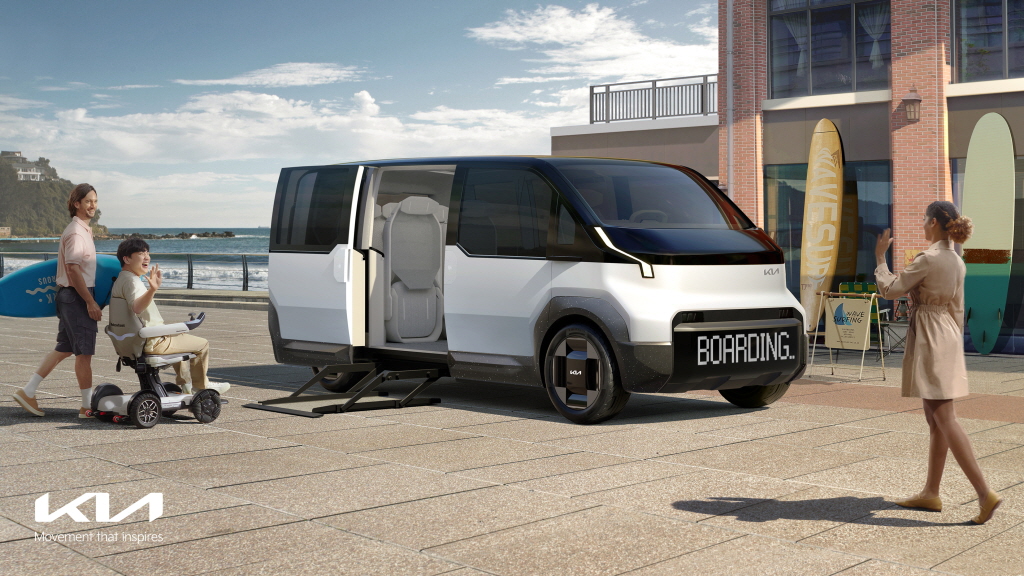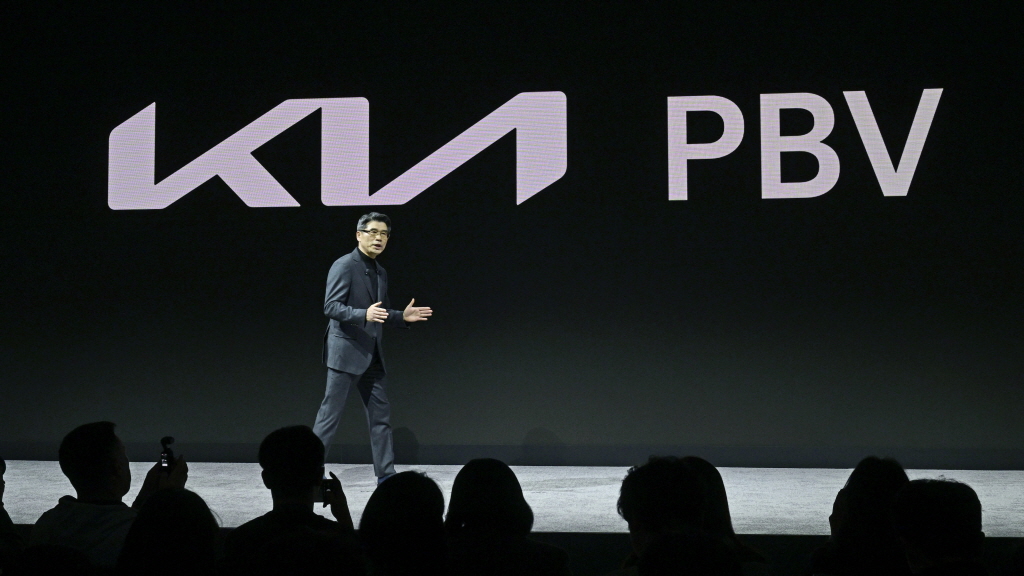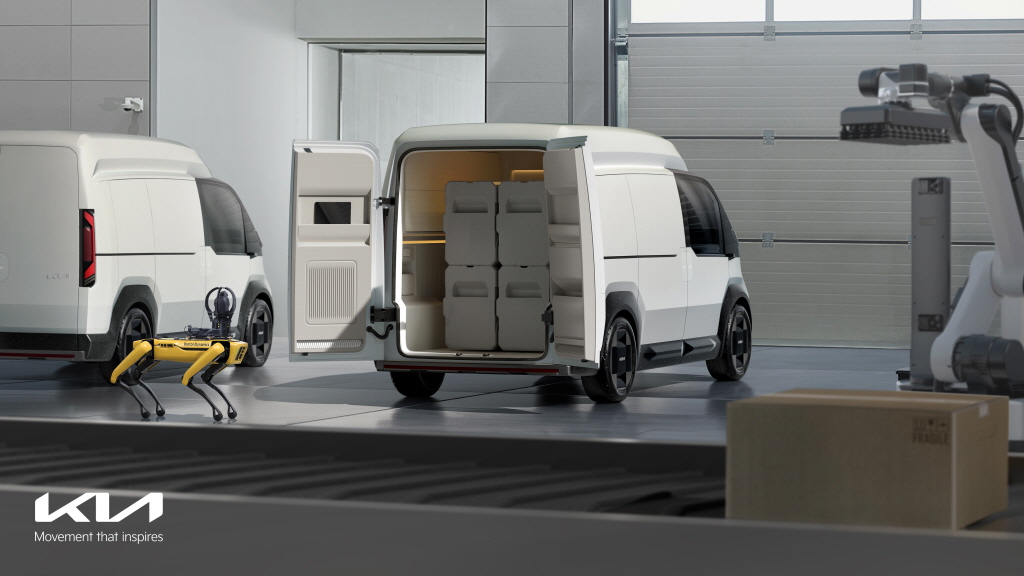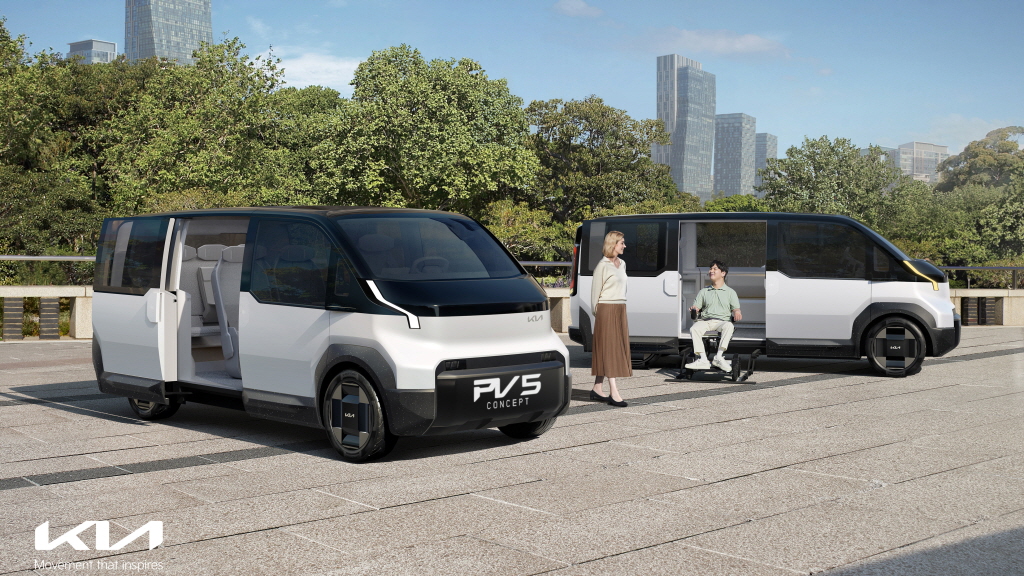기아는 5년만에 참가한 CES 2024에서에서 ‘준비된 기아가 보여줄, 모두를 위한 모빌리티(All Set for Every Inspiration)’를 주제로 미디어 데이를 열고 ‘영감을 주는 공간(Place of Inspiration)’이라는 테마 아래 기아의 지속 가능한 PBV 전략을 보여줄 다양한 전시물을 공개했다.

▲기아 PV5 (그림 출처: 현대차그룹)
기아, CES 2024서 PBV 단계별 로드맵 비롯 구체적인 혁신 전략 공개
송호성 기아 사장 “PBV가 모빌리티의 표준이 되는 시대를 맞이하게 될 것”
기아가 5대의 PBV 콘셉트 모델 라인업을 비롯 ‘이지스왑’과 ‘다이나믹 하이브리드’ 등의 기술 등 이동수단의 혁신을 이끌 미래 핵심사업을 발표했다.
기아는 5년만에 참가한 CES 2024에서에서 ‘준비된 기아가 보여줄, 모두를 위한 모빌리티(All Set for Every Inspiration)’를 주제로 미디어 데이를 열고 ‘영감을 주는 공간(Place of Inspiration)’이라는 테마 아래 기아의 지속 가능한 PBV 전략을 보여줄 다양한 전시물을 공개했다.
기아 부스에는 △PV5 베이직 △PV5 딜리버리 하이루프 △PV5 샤시캡 등 PV5 콘셉트 모델 3대를 비롯해 △PV1 콘셉트 모델 1대 △PV7 콘셉트 모델 1대 등 총 5대의 PBV 콘셉트 모델 라인업을 CES 2024에서 최초로 공개하고, ‘이지스왑’과 ‘다이나믹 하이브리드’ 등 이동수단의 혁신을 이끌 미래 핵심사업을 소개했다.
이날 공개된 기아의 PBV 전략은 △전통적인 자동차의 개념을 탈피한 혁신적인 PBV 라인업 출시 △소프트웨어 기반의 최첨단 기술 적용 △파트너십 다각화를 통한 새로운 모빌리티 생태계 조성이며, 기아는 이를 통해 PBV 시장을 선도하는 브랜드로 거듭나겠다는 의지를 표명했다.
기아는 PBV 사업에 대한 자신감 및 준비된 모습을 통해 고객이 얻게 될 가치를 핵심으로 하는 ‘지속 가능한 PBV 모빌리티 솔루션의 미래 전략’을 공개했다.
 ▲송호성 기아 사장이 CES 2024 미디어 데이에서 발표하고 있다(사진 출처: 현대차그룹)
▲송호성 기아 사장이 CES 2024 미디어 데이에서 발표하고 있다(사진 출처: 현대차그룹)
송호성 기아 사장은 “기아는 2021년 ‘브랜드 리런치’ 이후 획기적인 전기차 라인업 구축, 고객 중심의 모빌리티 미래 제시, 글로벌 비영리 단체 ‘오션 클린업’과의 파트너십과 같은 글로벌 지속 가능성 이니셔티브 전개 등 다양한 여정을 이어왔다”며 “이제 새로운 도약을 위한 핵심 전략으로 PBV를 설정하고 지속 가능한 모빌리티 플랫폼으로의 본격 전환을 준비하고자 한다”고 밝혔다.
■ 기아가 재정의한 PBV…‘Platform Beyond Vehicle, 차량 그 이상의 플랫폼’
기아가 추구하는 PBV는 기아의 미래 비전인 ‘Sustainable Mobility Solutions Provider’(지속 가능한 모빌리티 솔루션 프로바이더)를 바탕으로 고객 만족을 넘어선 그 이상의 경험을 제공한다.
기아는 PBV를 통해 스마트 모빌리티와 공유 경제, 이커머스 등 급속한 디지털 전환이 이뤄지는 상황에서 새로운 미래 방향성을 제시하는 것을 목표로 하고 있다.
이를 위해 기아는 CES 2024에서 PBV의 개념을 ‘Platform Beyond Vehicle(차량 그 이상의 플랫폼)’로 재정의했다.
자유로움과 유연성을 갖춘 맞춤형 설계로 새로운 비즈니스와 라이프스타일 제공은 물론, 혁신적인 공간 활용을 통한 효율적인 차량 내 경험을 제공한다는 것이 핵심이다.
기아는 새롭게 정의한 PBV 사업을 통해 글로벌 시장과 비즈니스 환경에 최적화된 차량과 서비스로 다양한 고객과 지역사회의 수요를 충족시킴으로써 전통적인 자동차의 개념을 뛰어 넘겠다는 계획을 밝혔다.
.jpg) ▲기아 PBV 라인업(그림 출처: 현대차그룹)
▲기아 PBV 라인업(그림 출처: 현대차그룹)
기아는 이러한 비전을 바탕으로 △중형 → 대형 → 소형으로 이어지는 PBV 라인업 구축 △완전한 맞춤화(비스포크) 제작 등을 내용으로 하는 단계별 PBV 로드맵을 공개했다.
기아는 2025년 첫 중형 PBV인 PV5를 출시하고 PBV 사업을 본격 전개한다.
차량 호출, 배달, 유틸리티 등의 사용 목적에 따라 다양한 라이프 모듈을 교체할 수 있는 컨버전 기능을 탑재하고, SDV와 경로, 정보 등 외부 데이터 간 연결성을 강화해 여러 대의 차량을 동시에 운영할 수 있도록 할 계획이다.
이어 대형 및 소형 PBV 라인업을 추가해 대형 물류 회사나 모빌리티 기업, 개인 사용자로 영역을 확대한다.
이 단계에서 디지털 제어 및 자율주행 기술이 기아 PBV에 본격적으로 적용되며, 인공지능 기반 차량 관제 및 관리 지원으로 데이터 연결 범위를 확대할 계획이다.
로보틱스 등 미래 기술과 연계한 새로운 형태의 비즈니스도 추진한다.
이후에는 PBV를 완전하게 개인의 기호와 목적에 따라 맞춤 제작하는 ‘비스포크 모빌리티 솔루션’ 형태로 발전시킨다.
 ▲기아 PV5 (그림 출처: 현대차그룹)
▲기아 PV5 (그림 출처: 현대차그룹)
이와 같은 단계별 로드맵 추진을 통해 기아 PBV는 △자율주행 △미래항공 모빌리티(AAM, Advanced Air Mobility) △로보틱스 △에너지 그리드 등의 미래 기술과 현대자동차그룹의 SDV 전략과 연계한 PBV 생태계를 조성함으로써 기아의 비전인 ‘Platform Beyond Vehicle’을 달성한다는 목표다.
송호성 사장은 “PBV는 머지않아 모빌리티의 세계를 혁신적으로 변화시킬것이며, 많은 사람들은 PBV가 모빌리티의 표준이 되는 시대를 맞이하게 될 것”이라며 “기아는 일하고 이동하는 방식, 나아가 삶의 방식을 변화시키기 위해 존재하는 모든 영감을 받아들이고 실행시킬 준비가 되어 있다”고 말했다.
■ 기아, PBV 라인업 기반 되는 PV5 등 라인업 다변화
기아 PBV 라인업은 단순하면서도 직관적인 디자인을 바탕으로 견고하고 강인한 캐릭터를 구현했다.
이와 함께 스케이트보드 기반의 PBV 전용 EV 플랫폼 위에 다양한 수요를 반영한 모듈(어퍼바디)을 체결하는 형태를 채택해 활용도를 극대화했으며, 모든 기능은 쉽고 직관적으로 사용 가능하도록 만들어졌다.
기아 최초의 전용 PBV 모델이자 PBV 라인업의 기반이 되는 PV5는 전용 EV 플랫폼과 확장된 휠베이스가 만들어낸 넓고 평평한 실내 공간이 특징이다.
 ▲기아 PV5 (그림 출처: 현대차그룹)
▲기아 PV5 (그림 출처: 현대차그룹)
책상과 같은 평면을 제공하는 운전석 콕핏과 위로 꺾어서 책상 램프로 활용할 수 있는 스티어링 휠은 운전자에게 사무실과 같은 경험을 제공한다.
PV5는 △베이직(Basic) △딜리버리(Van) △딜리버리 하이루프(High Roof) △샤시캡(Chassis Cab) 등 다양한 버전으로 출시될 예정이다.
향후에는 모셔널과 함께 개발한 로보택시(Robotaxi) 모델도 선보인다.
로보택시는 자율주행 기술을 기반으로 헤일링(차량호출) 서비스의 혁신을 불러 일으킬 것으로 기아는 기대하고 있다.
기아는 CES 2024에서 PV5 콘셉트 모델 외에도 PV7과 PV1 콘셉트 실물도 공개했다.
대형 PBV인 PV7은 라인업 가운데 가장 넓은 공간을 제공하며 주행 거리도 길어 다양한 용도에 적합한 모델이다.
소형 PBV인 PV1는 단거리 물류 운송에 최적화된 모델로, 드라이빙 모듈을 사용해 좁은 공간에서 회전 반경을 최소화할 수 있다.
직각 운행이나 사선 주행, 제자리 회전, 피봇 턴(Pivot Turn·원하는 위치로 차량을 자유롭게 회전시키는 것) 등 자유로운 움직임이 가능해 운행이 불가능한 좁은 공간에서도 빠르게 이동할 수 있다.
기아는 장거리 물류에 특화된 PV7과 민첩한 이동이 가능한 PV1의 시너지를 통해 물류의 시작부터 라스트마일 딜리버리(Last Mile Delivery)까지 포괄하는 최적의 운송 솔루션을 제공할 수 있을 것으로 예상하고 있다.
카림 하비브 기아 부사장은 “기아가 선사할 PBV 경험은 차량의 물리적 경계를 넘어 고객의 삶과 필요에 맞춰 확장될 것”이라며 “기아 PBV는 고객들의 일상을 보다 효율적이고 즐겁게 만들어주는 최고의 비즈니스 및 라이프스타일 파트너가 될 것”이라고 말했다.
■ 기아, PBV 적용 이지스왑·다이나믹 하이브리드 등 혁신 기술 소개
기아는 PBV 상품기획·개발 단계부터 고객의 의견을 반영하는 ‘고객 참여형 차량 개발 프로세스’를 신규 도입하여 고객 중심 제조 혁신에 나선다.
고객별 맞춤형 솔루션을 제공할 수 있는 ‘PBV 전용 비즈니스 시스템’을 구축하고, 다양한 고객 요구에 부합하는 차량을 선보일 예정이다.
이를 위해 기아는 오토랜드 화성에 연간 15만대 수준의 생산능력을 갖춘 PBV 전기차 전용공장 '이보 플랜트(EVO Plant)’를 구축하고 있다.
‘진화’를 뜻하는 이볼루션(Evolution)에서 따온 이보 플랜트는 디지털 기술과 로봇이 적용되고 컨베이어 시스템과 셀 생산방식이 접목된 혁신적 생산체계를 갖춰 PBV 본격 양산을 위한 스마트 팩토리로서 역할을 하게 된다.
기아 PBV의 혁신은 ‘이지스왑’(Easy Swap) 기술에 힘 입어 극대화될 전망이다.
이지스왑은 소비자의 스타일에 맞게 라이프 모듈을 교체하여 사용할 수 있는 기술이다.
전통적인 볼트 체결 방식 대신 마그네틱 체결과 기계적 체결을 결합한 하이브리드 유닛을 통해 별도의 차량을 신규로 구입하지 않아도 원하는 비즈니스 형태에 따라 차체에 변화를 줄 수 있다.
기아 PBV의 다품종 소량생산 생산체계를 이끌 ‘다이나믹 하이브리드’(Dynamic Hybrid) 기술도 눈길을 끈다.
다이나믹 하이브리드는 고객의 다양한 요구에 맞춰 차체 크기나 높이 등을 기호에 맞게 조정할 수 있게 하는 기술이다.
향후 본격화될 다품종 소량생산에 대응할 수 있는 수평·수직적 확장이 가능한 조립방식으로 꼽힌다.
기아는 PBV를 이용하는 고객이 각자의 비즈니스에 최적화된 PBV 솔루션을 제공받을 수 있는 소프트웨어를 준비 중이다.
소프트웨어는 크게 △IVI(In-Vehicle Infotainment, 차량용 인포테인먼트) △FMS(Fleet Management System, 차량 관제 시스템) △Charging(충전) 등 세 가지 영역으로 나뉜다.
우선, IVI는 고객이 필요한 서비스를 직접 개발해 PBV 애플리케이션 마켓에 바로 반영하거나 제3의 개발자를 통해 제공받을 수 있다.
또 이동 과정에서 최신 정보와 엔터테인먼트 콘텐츠를 즐길 수 있고 충전이나 주차, 결제 등 데이터와 결합된 개인화 서비스도 이용할 수 있다.
FMS는 PBV의 안정적 운영을 지원하는 소프트웨어다.
데이터 수집이나 관리 용도의 별도 기기 없이도 차량 데이터를 활용해 실시간으로 운행 제어가 가능하며, AI 기술을 기반으로 운행패턴과 고장형태를 분석해 운전자에게 예측 정비 정보를 제공한다.
충전의 경우, 충전 스케줄이나 운행경로, 일정 등을 고려한 충전 컨설팅을 기반으로 고객에게 최적화된 충전 일정과 충전소를 안내한다.
또 V2X 등 최적의 충전 인프라를 기반으로 하는 고밀도 에너지 배터리를 활용해 모바일 기기나 비상 장비 등에도 전원을 공급할 수 있다.
피에르 마르탱 보 기아 PBV비즈니스 사업부 상무는 “기아 PBV의 소프트웨어는 이동 편의성을 증가시키는 것은 물론, 고객 비즈니스 차별화까지 도모한다”며 “기아 PBV는 소프트웨어와 다양한 비즈니스 경험을 축적하며 차량 간 연결성을 강화하고, 나아가 사회 인프라를 통합시킬 플랫폼으로 거듭날 것”이라고 말했다.
■ PBV 생태계 조성 위해 다양한 글로벌 파트너와 협력
기아는 PBV 사업을 통해 각 영역별 고객의 니즈를 충족시키는 것을 목표로 하고 있다. 이를 위해 PBV에 특화된 ‘Kia PBV Partners Day’를 도입하고, 다양한 고객의 요구사항을 반영하는 프로세스를 최초로 시도한다.
기아는 아울러 PBV를 통한 새로운 모빌리티 생태계를 위해 다양한 파트너들과 협력하기로 했다.
기아는 우버와 쿠팡, CJ대한통운, 카카오모빌리티 등의 기업과 파트너십을 맺고 PBV 전용 사업 체계를 더욱 강화하고, 모셔널과 함께 레벨4 수준의 자율주행이 가능한 PBV 로보택시를 개발할 예정이다.
 ▲기아 PV5 (그림 출처: 현대차그룹)
▲기아 PV5 (그림 출처: 현대차그룹)
.jpg) ▲기아 PBV 라인업(그림 출처: 현대차그룹)
▲기아 PBV 라인업(그림 출처: 현대차그룹)
 ▲기아 PV5 (그림 출처: 현대차그룹)
▲기아 PV5 (그림 출처: 현대차그룹)